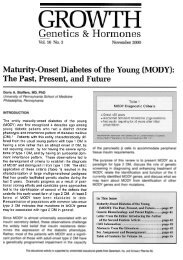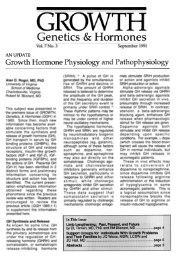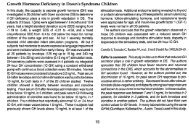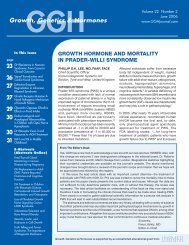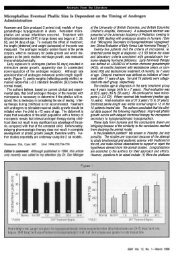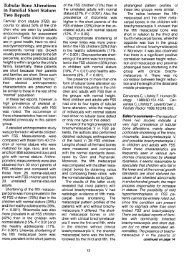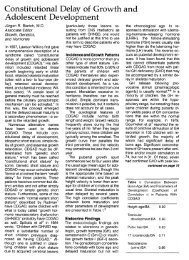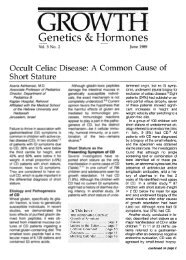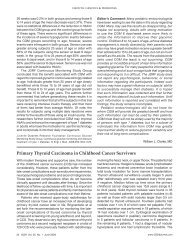The Final Phase of Growth in Stature - GGH Journal
The Final Phase of Growth in Stature - GGH Journal
The Final Phase of Growth in Stature - GGH Journal
Create successful ePaper yourself
Turn your PDF publications into a flip-book with our unique Google optimized e-Paper software.
1.5 cm for males and 1.0 cm for<br />
females.1 <strong>The</strong> f<strong>in</strong>al phase <strong>of</strong><br />
growth <strong>in</strong> stature probably reflects<br />
elongation <strong>in</strong> the vertebral column.<br />
Increments after Peak Height<br />
Velocity (PHV) and Menarche<br />
<strong>The</strong> distributions <strong>of</strong> the total <strong>in</strong>crements<br />
after PHV are slightly larger<br />
for boys than for girls, with large<br />
differences between the 10th and<br />
90th percentile levels <strong>in</strong> each sex<br />
(Table 2). <strong>The</strong>se sex-associated<br />
differences are particularly large<br />
for the first year after PHV. <strong>The</strong><br />
annual <strong>in</strong>crements decrease rapidly<br />
after PHV, with almost as much<br />
growth <strong>in</strong> the first year as <strong>in</strong> the<br />
second to fifth years comb<strong>in</strong>ed.<br />
<strong>The</strong> data for annual <strong>in</strong>crements<br />
after PHV do not add up to the total<br />
<strong>in</strong>crements, because the groups<br />
for the annual <strong>in</strong>crements differ<br />
across <strong>in</strong>tervals. It is noteworthy<br />
that at least 10% <strong>of</strong> the boys and <strong>of</strong><br />
the girls had <strong>in</strong>crements greater<br />
than 1.0 cm even from 4 to 5 years<br />
after PHV.<br />
<strong>The</strong> median total stature <strong>in</strong>crement<br />
after menarche was 7.4 cm<br />
with a 10th to 90th percentile range<br />
from 4.3 to 10.6 cm. <strong>The</strong>se f<strong>in</strong>d<strong>in</strong>gs<br />
are <strong>in</strong> agreement with reports <strong>of</strong><br />
growth from menarche to the end<br />
<strong>of</strong> school attendance or to 18.25<br />
years.6.? <strong>The</strong> median <strong>in</strong>crements<br />
dur<strong>in</strong>g the first year after menarche<br />
exceeded the sum <strong>of</strong> the<br />
median annual <strong>in</strong>crements over<br />
the next 4 years.<br />
Relationships to the Tim<strong>in</strong>g <strong>of</strong><br />
PHV and Menarche<br />
<strong>The</strong> later the occurrence <strong>of</strong> PHV<br />
and menarche, the lesser the<br />
growth <strong>in</strong> stature after these<br />
events 1,4,8,9 (Figure), After PHV,<br />
there was considerably more<br />
growth <strong>in</strong> boys than <strong>in</strong> girls for<br />
groups matched <strong>in</strong> age at PHV, but<br />
the ranges from the 5th to the 95th<br />
percentiles and the slopes <strong>of</strong> the<br />
regressions were almost identical<br />
<strong>in</strong> each sex, <strong>The</strong> <strong>in</strong>crements <strong>in</strong><br />
boys from 14 to 17 years are also<br />
negatively related to stature at 14<br />
years,10<br />
Cl<strong>in</strong>ical Applications<br />
<strong>The</strong> preced<strong>in</strong>g data may serve as<br />
guides to the potential for growth <strong>in</strong><br />
stature, depend<strong>in</strong>g on the patient's<br />
maturational status. This <strong>in</strong>formation<br />
therefore may assist decisions<br />
about the <strong>in</strong>itiation or<br />
cessation <strong>of</strong> therapy. Such decisions<br />
will be <strong>in</strong>fluenced as well by<br />
the presence and nature <strong>of</strong> any<br />
pathological condition and by the<br />
attitude <strong>of</strong> the patient and the patient's<br />
family.<br />
More complex procedures utilize<br />
regression equations to pre-<br />
dict adult stature from childhood<br />
variables.3.11,12 <strong>The</strong>se require assessments<br />
<strong>of</strong> skeletal age and,therefor<br />
cannot be used after<br />
maturation <strong>of</strong> the hand-wrist is<br />
complete. Prediction methods<br />
based on regression are likely to<br />
be mislead<strong>in</strong>g when applied to<br />
children with chronic diseases that<br />
affect growth, with large overpredictions<br />
more likely than underpredictions.<br />
<strong>The</strong> Bayley-<br />
P<strong>in</strong>neau method13 is the best current<br />
procedure for predict<strong>in</strong>g the<br />
adult statures <strong>of</strong> children with diseases;<br />
but even with this method,<br />
the prediction errors are large.12<br />
<strong>The</strong> present data should be applicable<br />
to healthy children, <strong>in</strong>clud<strong>in</strong>g<br />
those with statures or maturational<br />
levels unusual for their<br />
chronological ages.<br />
In mak<strong>in</strong>g decisions regard<strong>in</strong>g<br />
the cessation <strong>of</strong> growth-promot<strong>in</strong>gtherapy,<br />
cl<strong>in</strong>icians may utilize the<br />
distributions <strong>of</strong> age at which<br />
growth <strong>in</strong> stature ceases. 1 This<br />
approach is limited <strong>in</strong> value, how-




